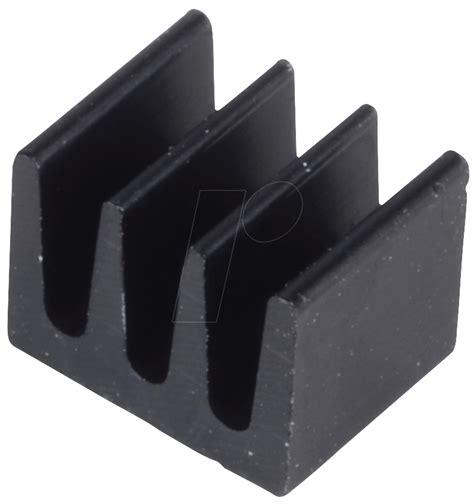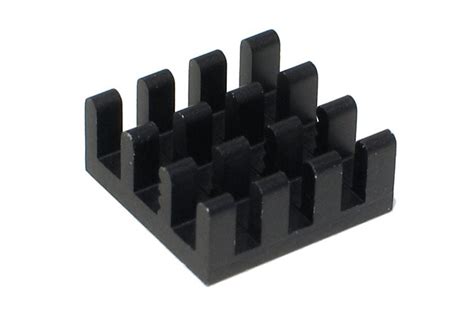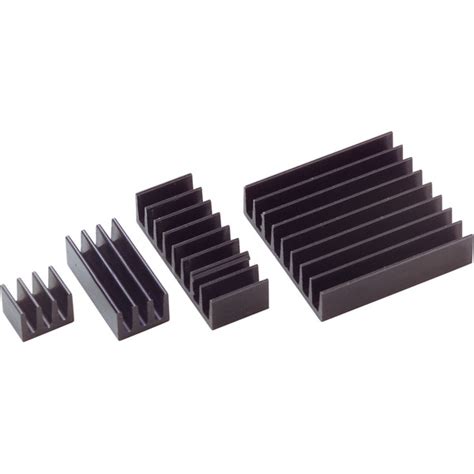Introduction to SMD Heat Sinks
Surface Mount Device (SMD) heat sinks are essential components in modern electronic devices that help dissipate heat generated by various components on a Printed Circuit Board (PCB). As electronic devices continue to shrink in size while increasing in performance, the need for efficient heat dissipation becomes more critical. SMD heat sinks provide an effective solution to this problem by efficiently transferring heat away from the heat-generating components, thereby preventing overheating and ensuring optimal performance of the device.
What are SMD Heat Sinks?
SMD heat sinks are small, compact devices designed to be mounted directly onto the surface of a PCB. They are typically made of materials with high thermal conductivity, such as aluminum or copper, which allows them to quickly absorb and dissipate heat from the components they are attached to. SMD heat sinks come in various shapes and sizes, depending on the specific application and the amount of heat that needs to be dissipated.
Why are SMD Heat Sinks Important?
As electronic devices become more powerful and compact, the amount of heat generated by the components on a PCB increases. If this heat is not effectively dissipated, it can lead to a range of problems, including:
- Reduced performance: Overheating can cause components to operate at a reduced capacity, leading to slower processing speeds and overall performance.
- Decreased lifespan: Prolonged exposure to high temperatures can cause components to degrade faster, reducing their lifespan and increasing the risk of failure.
- Device malfunction: In extreme cases, overheating can cause components to fail completely, rendering the device inoperable.
SMD heat sinks help mitigate these issues by providing an efficient means of transferring heat away from the components, ensuring that they operate within their optimal temperature range.
Types of SMD Heat Sinks
There are several types of SMD heat sinks available, each with its own unique features and benefits. Some of the most common types include:
Stamped SMD Heat Sinks
Stamped SMD heat sinks are manufactured by stamping a flat sheet of metal, typically aluminum, into the desired shape. They are often used in applications where a low profile is required, as they can be made very thin while still providing effective heat dissipation. Stamped SMD heat sinks are also relatively inexpensive to produce, making them a popular choice for cost-sensitive applications.
Extruded SMD Heat Sinks
Extruded SMD heat sinks are created by forcing molten metal through a die to create a specific cross-sectional shape. This process allows for the creation of heat sinks with more complex geometries, such as fins or pins, which can increase the surface area available for heat dissipation. Extruded SMD heat sinks are often used in applications where a higher level of heat dissipation is required, such as in power electronics or high-performance computing.
Forged SMD Heat Sinks
Forged SMD heat sinks are created by compressing a heated metal blank in a mold to create the desired shape. This process results in a heat sink with a very dense, fine-grained structure, which provides excellent thermal conductivity. Forged SMD heat sinks are often used in applications where high reliability and durability are required, such as in aerospace or military electronics.
Comparison of SMD Heat Sink Types
| Type | Advantages | Disadvantages |
|---|---|---|
| Stamped | Low profile, cost-effective | Limited heat dissipation capacity |
| Extruded | Complex geometries, high heat dissipation capacity | Higher cost compared to stamped heat sinks |
| Forged | Excellent thermal conductivity, high reliability | Highest cost, limited design flexibility |

Factors Affecting SMD Heat Sink Performance
Several factors can impact the performance of an SMD heat sink, including:
Material Properties
The thermal conductivity of the material used to construct the heat sink is a critical factor in its performance. Materials with higher thermal conductivity, such as copper or aluminum, are better able to transfer heat away from the components and into the surrounding environment. The following table compares the thermal conductivity of common heat sink materials:
| Material | Thermal Conductivity (W/mK) |
|---|---|
| Copper | 401 |
| Aluminum | 205 |
| Brass | 109 |
| Steel | 50.2 |
Surface Area
The surface area of the heat sink directly affects its ability to dissipate heat. A larger surface area allows for more heat to be transferred into the surrounding air, improving the overall cooling performance. SMD heat sinks with features such as fins or pins can significantly increase the surface area available for heat dissipation.
Thermal Interface Material
The thermal interface material (TIM) is a substance applied between the heat-generating component and the heat sink to improve thermal conductivity. Common TIMs include thermal grease, thermal pads, and phase change materials. The choice of TIM can significantly impact the overall heat dissipation performance of the SMD heat sink.
Airflow
The amount of airflow available to the heat sink can also affect its performance. In applications where natural convection is relied upon for cooling, the heat sink must be designed to maximize airflow around its surface. In applications where forced convection is used, such as with a fan, the heat sink design can be optimized for the specific airflow characteristics of the system.

Designing with SMD Heat Sinks
When designing a PCB that incorporates SMD heat sinks, several factors must be considered to ensure optimal performance and reliability.
Component Placement
The placement of components on the PCB can have a significant impact on the effectiveness of the SMD heat sinks. Heat-generating components should be placed as close as possible to the heat sinks to minimize the distance that heat must travel. Components with similar thermal requirements should also be grouped together to simplify the heat sink design.
PCB Layout
The layout of the PCB itself can also affect the performance of the SMD heat sinks. The PCB should be designed to minimize the thermal resistance between the heat-generating components and the heat sinks. This can be achieved by using wide, short traces to connect the components to the heat sinks and by providing adequate copper coverage on the PCB to improve thermal conductivity.
Heat Sink Selection
The selection of the appropriate SMD heat sink for a given application requires careful consideration of several factors, including:
- The amount of heat generated by the components
- The available space on the PCB
- The desired thermal performance
- The cost and availability of the heat sinks
Designers must carefully balance these factors to select an SMD heat sink that provides the necessary cooling performance while meeting the other constraints of the design.

Application Examples
SMD heat sinks are used in a wide range of electronic applications, from consumer devices to industrial equipment. Some common examples include:
Power Electronics
Power electronic devices, such as voltage regulators and motor controllers, generate significant amounts of heat during operation. SMD heat sinks are often used to dissipate this heat, ensuring that the devices operate within their safe temperature limits. In these applications, extruded or forged heat sinks with high heat dissipation capacities are commonly used.
High-Performance Computing
Modern high-performance computing systems, such as servers and workstations, rely on powerful processors and graphics cards that generate substantial amounts of heat. SMD heat sinks are used to cool these components, often in conjunction with forced air cooling systems. Stamped or extruded heat sinks with large surface areas are commonly used in these applications.
Automotive Electronics
The harsh environment of a vehicle, combined with the increasing complexity of automotive electronic systems, makes effective heat dissipation a critical concern. SMD heat sinks are used in a wide range of automotive applications, from engine control units to infotainment systems. In these applications, heat sinks must be designed to withstand the vibration and temperature extremes encountered in a vehicle.
Conclusion
SMD heat sinks play a vital role in ensuring the reliable operation and longevity of modern electronic devices. By efficiently dissipating heat away from critical components, these compact, surface-mounted devices help prevent overheating and ensure optimal performance. When designing with SMD heat sinks, careful consideration must be given to factors such as material properties, surface area, thermal interface materials, and airflow to ensure the best possible thermal performance. As electronic devices continue to push the boundaries of performance and miniaturization, the importance of effective heat dissipation solutions like SMD heat sinks will only continue to grow.
Frequently Asked Questions (FAQ)
- What is the difference between an SMD heat sink and a through-hole heat sink?
-
SMD heat sinks are designed to be surface mounted directly onto a PCB, while through-hole heat sinks are mounted using pins that pass through holes in the PCB. SMD heat sinks are generally more compact and easier to install, while through-hole heat sinks can provide better mechanical stability in some applications.
-
Can SMD heat sinks be used with any component?
-
SMD heat sinks are designed to be used with components that generate significant amounts of heat, such as power transistors, voltage regulators, and processors. Not all components require heat sinks, and the specific heat sink required will depend on the thermal characteristics of the component and the application.
-
How do I select the right SMD heat sink for my application?
-
Selecting the right SMD heat sink requires careful consideration of factors such as the amount of heat generated by the component, the available space on the PCB, the desired thermal performance, and the cost and availability of the heat sinks. It is often helpful to consult with a thermal management expert or use thermal modeling software to help select the most appropriate heat sink for a given application.
-
Can I use thermal adhesive to attach an SMD heat sink?
-
Yes, thermal adhesive can be used to attach an SMD heat sink to a component. Thermal adhesive provides both a mechanical bond and a thermal interface between the component and the heat sink. However, it is important to select a thermal adhesive that is compatible with the materials used in the heat sink and the component, and to apply the adhesive correctly to ensure optimal thermal performance.
-
How do I ensure optimal airflow around my SMD heat sinks?
- To ensure optimal airflow around SMD heat sinks, it is important to consider factors such as the placement of the heat sinks on the PCB, the orientation of the PCB within the enclosure, and the overall airflow characteristics of the system. In applications where natural convection is used for cooling, heat sinks should be placed in a way that maximizes air movement around their surfaces. In applications where forced convection is used, heat sinks can be designed to optimize airflow based on the specific characteristics of the cooling system.

Leave a Reply